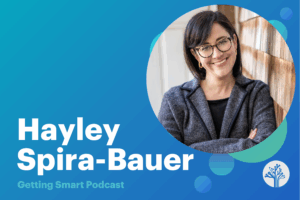A Culture of No: How to Get Past Fear and Risk-Aversion to Make Things Happen
Key Points
-
What are a few other straightforward moves an educational leader can make to ensure they can push break-the-mold, innovative changes needed in education today?
-
Is the culture of education simply too deep and unmovable to be creative and move forward?

I’ve had the unique privilege of moving between business and education throughout my career, including getting to work with some highly dynamic and influential business leaders in my community. One of the biggest differences between business leaders and school and district leaders has been how quickly and easily business gets to “yes” while education seems to wallow in the purgatory of the “yeah but…” and the “no.”
Some of the reasons behind this are quite easy to recognize. Schools as public entities have to appeal to a wide, and often vocal, constituency. Boards made up of lay people, not experts in important-to-the-business fields like a for-profit board, are working for free. These caring public servants are faced with critical decisions about both money and programming. They experience constant pressure from a variety of interest groups wanting or not wanting specific things. Add to the fact that every decision that is made is open to public scrutiny and debate, made easier due to the pervasive existence of social media.
Superintendents, who hold the power to make major changes as well, are always just one Board election away from being out of a job if they make a “mistake” or move too quickly. The typical implicit Board directive is, “Make us great, be innovative, but don’t really change anything.” Parents, teachers, principals, city government, and local businesses all have an opinion about what should and shouldn’t happen and aren’t afraid to leverage their political power to move things their way.
These contextual realities create a pervasive and long-standing culture that is highly risk-averse and often driven by fear-based decisions. What will happen to us if we say yes? In systems like education, there is virtually no immediate or visible cost to saying “no.” It’s almost as if there is no opportunity cost to saying “no” (a huge faulty assumption). Saying “yes,” however comes with lots of very visible “costs” and a very public eye with people waiting for any reason to point out why it doesn’t work.
Here’s a recent example that illuminates this issue. Over the past few months, I’ve been involved with both district leadership and two influential CEOs of large, locally-based companies to find a home downtown for a new magnet high school. This high school focused on getting students out into the community to work on real problems, building real skills, and applying academic standards in messy, contextualized situations. The lead administrator is very supportive of this effort and wants it to work. This example isn’t about any individual and instead about how a system shapes a leader’s behavior.
We immediately ran into all sorts of barriers and challenges from being able to afford a downtown space, to code issues, to design challenges. At each turn, the two CEOs opened with, “Okay, so how do we solve it? How much money do we need to raise? Who can we contact to help us navigate code issues to get what we want? How can we think about this on different scales? What can we do right now? etc.” This immediately led to some creative and exciting solutions. The district’s focus? “We can only spend X. I’m not sure if the Board will like this idea. I don’t think we can make that happen. I don’t think we have internal support for this. We need more people looking at this, etc.” After about the 2nd meeting, our administrator turned to the group with a smile on his face and said, “I just realized after these meetings that I am the bureaucracy.” It was like the fish recognizing he was swimming in water.
Schools as public entities have to appeal to a wide, and often vocal, constituency.
Trace Pickering
So what does all of this mean? Is the culture of education simply too deep and unmovable to be creative and move forward? Well, it is certainly a big challenge, but enough examples around the country show us it is not unsurmountable. It can all start with that one administrator recognizing they are inadvertently seeking a “no” answer. Since that meeting, I’ve seen this administrator make a subtle but powerful shift in his approach. I now hear him saying things like, “We need to make this happen. What are the big barriers you see now? Let’s identify them and rally around to get them removed.” I see him leading upward more now, making sure the people above him in the organization understand what we’re doing and why. He’s asking for forgiveness now a lot more than he’s asking for permission.
What are a few other straightforward moves an educational leader can make to ensure they can push break-the-mold, innovative changes needed in education today?
1. Find key leaders in your community and engage them.
Don’t focus on your needs, focus on theirs. They want and need a more skilled workforce and they don’t see schools as listening and responding. Listen, go talk to the Chamber. Take your Board president with you. Then, use the things they say they need and center that in any design you put together. You can then blend in the things we know need to happen to free up students to do these things. Like, rethinking course offerings that are more student-interest-based, interdisciplinary, and focused on the application of skills. Like, For bringing staff on board whose sole job is to connect with the community to find students interesting projects and job experiences.
Now, you not only have a Board President who sees what you’re doing and why, but you also have key, vocal leaders in the community willing and able to stand with you as you push forward these innovations.
2. Simply change your language.
Listen carefully to how you speak of things. Is your first response a question with undertones of “no”? (E.g. “Where would the funding come for this?” “Do you have all the details worked out?”). Instead, approach it with positive curiosity. (E.g. “Nice! What sorts of opportunities would this open up for students?” “Interesting, tell me what you’ve already thought through.”)
3. Quit demanding that all the details be worked out first.
Quickest way to kill anything? Demand all details be worked out ahead of time. First, this is impossible. Second, while seeming counterintuitive, the more you have worked out ahead of time, the more you’re going to find yourself defending the decision when lots of it crashes and burns with the realities of practice. Demand a clear vision and basic direction. Speak in terms of “first iterations.” Help the designers focus on a few key things to get clarity around and allow them to learn on the fly once implementation starts.
4. Be honest with the public.
Make a strong case for the why and make it crystal clear that this won’t go smoothly because we won’t know what we need to know until we get started. Promise that while there will be missteps in the work, the well-being and success of the students will remain at the center.
5. Don’t let the “system” determine all the success measures.
Any substantive change is likely to cause the system’s definition of success to not be immediately met. Have other critical outcomes and measures. Student engagement and sense of joy. Students’ sense of belonging and worth. A number of community projects, job shadows, etc completed. Get students in front of the Board and community talking about how this school/program is changing their trajectories and feelings of accomplishment and belonging. The system’s measures will come with a bit of time – often no worse than what the current system is producing.






0 Comments
Leave a Comment
Your email address will not be published. All fields are required.